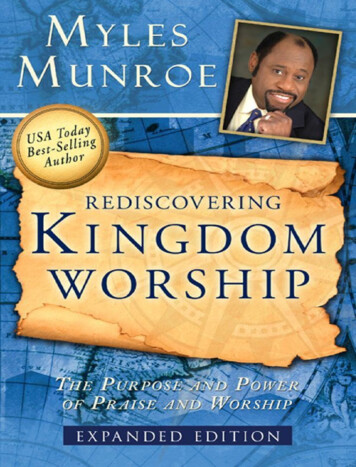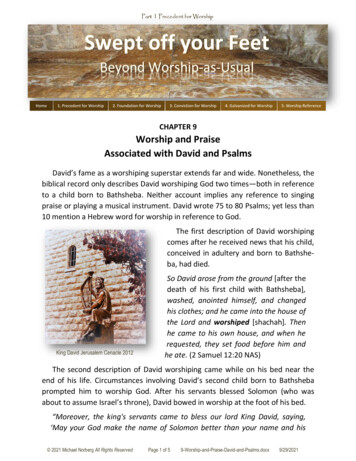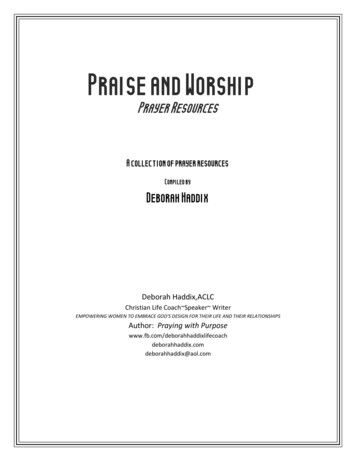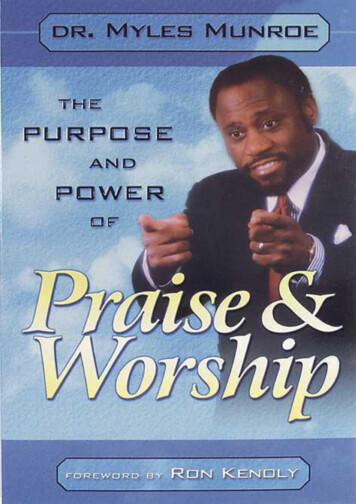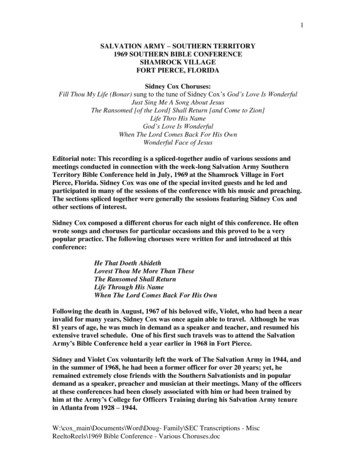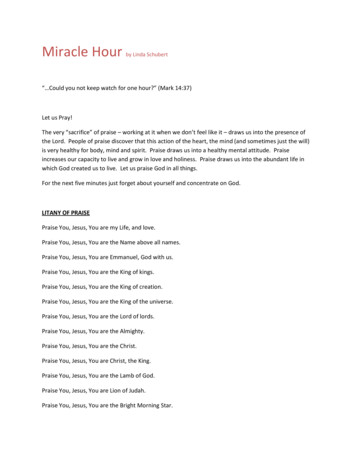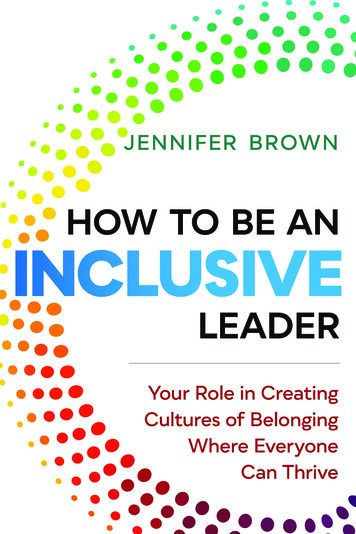
Transcription
Praise for How to Be an Inclusive Leader“Though most leaders possess the desire to have more inclusive organizations,many quietly struggle with the challenge of not knowing how. Jennifer Brown’sHow to Be an Inclusive Leader gives courageous and compassionate executives a simple yet powerful blueprint for how to create true belonging and aculture where everyone can thrive. I highly recommend this book.”—Rha Goddess, founder and CEO, Move the Crowd, and author of The Calling“Jennifer and I have a shared purpose in inspiring people to become the inclusive leaders our world needs. This book brings that purpose to life in a necessary read—an intuitive, accessible road map that will inspire you to step up,put your voice into action, and discover how to play a part in building inclusiveorganizations for all.”—Torin Perez, TED Resident and author of Who Am I to Lead?“With this important contribution, Jennifer Brown invites readers to see themselves in the inclusion conversation and in the solution. How to Be an InclusiveLeader provides a road map to step into conversations, however imperfectly,and to learn to take action—and ultimately become someone others wouldconsider an ally or advocate.”—Michael Skolnik, cofounder of The Soze Agency“From subconscious biases that affect hiring decisions to systemic blind spotsthat perpetuate unequal advancement opportunities, the modern workforce isrife with inequalities. How to Be an Inclusive Leader is all about deepeningyour awareness so you can be a part of the solution. Jennifer is giving the callto action we all need!”—Adam Pisoni, founder and CEO, Abl Schools“This is the essential book so many people have been asking for. A clear howto guide that meets leaders where they are and helps them move forward asinclusive leaders. Jennifer Brown guides us with grace and candor through hereasy-to-understand framework of becoming an inclusive leader. Whether youhave long been part of this conversation or are just joining it, this book hasmuch to offer.”—Dolly Chugh, Associate Professor, NYU Stern School of Business, and author ofThe Person You Mean to Be“Sometimes it seems like inequality is a massive, unfixable problem. This bookshows that isn’t true. Every single person can take simple steps to make his orher organization a more welcoming, inclusive environment where everyone canthrive. This book is an exceptional resource for the modern leader!”—Aaron Hurst, cofounder and CEO, Imperative, author of The Purpose Economyand Fast Company’s Purposeful CEO series, and founder of Taproot FoundationInclusiveLeader.indd 15/29/19 12:38 AM
“Jennifer’s book is a must-read for anyone passionate about excelling in the artof inclusion.”—Tina Alexis Allen, actress and author of Hiding Out“To feel joy at work and do good work, we need to be ourselves and be appreciated for the talent we bring. Yet it’s not easy to create an inclusive workplacewithout the skill and information we need to do that. Jennifer Brown’s bookprovides that resource to enable us, as employers, to transform our workplaceinto one in which all employees feel that they belong.”—Louise Chernin, President and CEO, GSBA, Washington State’s LGBTQ Chamberof Commerce“Creating a culture of belonging requires each of us to harness our ability, andour responsibility, to ensure others are welcomed, valued, respected, andheard. With this book, Jennifer is empowering each of us with the tools to effect meaningful change in our workplaces.”—Kimberley Messer, Global Diversity Business Development Leader, NorthAmerica, IBM“With How to Be an Inclusive Leader, Jennifer Brown clearly shares what anyindividual can do to leverage one’s privilege on behalf of those who may notyet have an influential voice, as well as help shape the solutions. It’s ultimatelyabout becoming a leader—a meaningful ally and equality advocate for all.”—Monica L. Boll, Managing Director and Operations Account Executive,Accenture“Wow! Jennifer Brown really gets it. Her book How to Be an Inclusive Leaderis a smart, moving, and—best of all—convincing manual for how to becomethe inclusive leaders we so desperately need. Her sage advice is perfect for allleaders, regardless of where they’re starting on the path to becoming awareof privilege and bias and no matter the industry. This is one heck of a humanbook that really just might change the world.”—Erica Keswin, founder of the Spaghetti Project and author of Bring Your Humanto Work“Jennifer takes a tricky and nuanced subject and makes it accessible and encouraging. I love how she gives the tools needed to create change from bothan individual and organizational level, using compelling examples across industries.”—Claire Wasserman, founder and CEO, Ladies Get PaidInclusiveLeader.indd 25/29/19 12:38 AM
HOW TO BE ANINCLUSIVELEADERInclusiveLeader.indd 15/29/19 12:38 AM
HOW TO BE ANINCLUSIVELEADERYour Role in Creating Cultures ofBelonging Where Everyone Can Thrivefor printing on spine of paper covemping on spine of cloth coverLogos for BK NO-AGENDA booksJENNIFER BROWNLogos can be any color, but any one instance of the logoshould be all the same color.for title pageBerrett–Koehler Publishers, Inc.InclusiveLeader.indd 3Berrett–Koehler Publishers, Inc.Berrett–Koehler Publishers, Inc.5/29/19 12:38 AM
Copyright 2019 by Jennifer BrownAll rights reserved. No part of this publication may be reproduced, distributed, or transmitted in any form or by any means, including photocopying, recording, or other electronicor mechanical methods, without the prior written permission of the publisher, except inthe case of brief quotations embodied in critical reviews and certain other noncommercialuses permitted by copyright law. For permission requests, write to the publisher, addressed“Attention: Permissions Coordinator,” at the address below.Berrett- Koehler Publishers, Inc.1333 Broadway, Suite 1000Oakland, CA 94612-1921Tel: (510) 817-2277Fax: (510) 817-2278www.bkconnection.comORDERING INFORMATIONQuantity sales. Special discounts are available on quantity purchases by corporations,associations, and others. For details, contact the “Special Sales Department” at the Berrett- Koehler address above.Individual sales. Berrett- Koehler publications are available through most bookstores. Theycan also be ordered directly from Berrett- Koehler: Tel: (800) 929-2929; Fax: (802) 864-7626;www.bkconnection.com.Orders for college textbook / course adoption use. Please contact Berrett- Koehler:Tel: (800) 929-2929; Fax: (802) 864-7626.Distributed to the U.S. trade and internationally by Penguin Random House PublisherServices.Berrett- Koehler and the BK logo are registered trademarks of Berrett- Koehler Publishers, Inc.Printed in the United States of AmericaBerrett- Koehler books are printed on long- lasting acid- free paper. When it is available, wechoose paper that has been manufactured by environmentally responsible processes. Thesemay include using trees grown in sustainable forests, incorporating recycled paper, minimizing chlorine in bleaching, or recycling the energy produced at the paper mill.Library of Congress Cataloging- in- Publication DataNames: Brown, Jennifer, 1971- author.Title: How to be an inclusive leader : your role in creating cultures of belonging whereeveryone can thrive / Jennifer Brown.Description: First Edition. Oakland, CA : Berrett- Koehler Publishers, 2019.Identifiers: LCCN 2019011715 ISBN 9781523085170 (hardback)Subjects: LCSH: Leadership. Personnel management. Work environment. BISAC: BUSINESS & ECONOMICS / Human Resources & Personnel Management. BUSINESS & ECONOMICS / Workplace Culture. SOCIAL SCIENCE /Discrimination & Race Relations.Classification: LCC HD57.7 .B7656 2019 DDC 658.4/092—dc23LC record available at https://lccn.loc.gov/2019011715First Edition27 26 25 24 23 22 21 20 19 10 9 8 7 6 5 4 3 2 1Book producer and text designer: Maureen Forys, Happenstance Type- O- R amaCover designer: Dan Tesser, Studio CarnelianInclusiveLeader.indd 45/29/19 12:38 AM
Several generations of very special womenhave served as my pilot lights.To Deb Ziegler, who lifted me out ofdespair and showed me another wayto make my voice matter.To Mimi Brown, with whom I’ve conspiredfor years on deep matters of the soul.And most importantly, to my partnerMichelle whose activist spirit andcompanionship I take respite in, everyday of our lives together.InclusiveLeader.indd 55/29/19 12:38 AM
ContentsPreface . . . . . . . . . . . . . . . . . . . . . . . . . . . . . . . . . . . . . . ixINTRODUCTION From Unaware to Advocate . . . . . . . . . . . . . . . . . 1The Power of Being Inclusive . . . . . . . . . . . . . . . . . . . . . . . . 3Your Role . . . . . . . . . . . . . . . . . . . . . . . . . . . . . . . . . . . 7A New Theory of Change: The Inclusive Leader Continuum . . . . . . 9If You Can Get Them, Can You Keep Them? . . . . . . . . . . . . . . 13Before We Embark . . . . . . . . . . . . . . . . . . . . . . . . . . . . . 13The Inclusive Leader Continuum . . . . . . . . . . . . . . . . . . . . . 15CHAPTER ONE Starting Your Journey . . . . . . . . . . . . . . . . . . . . 17The Stages of the Inclusive Leader Continuum . . . . . . . . . . . . . 18Diversity Dimensions . . . . . . . . . . . . . . . . . . . . . . . . . . . 23The Tip of the Iceberg . . . . . . . . . . . . . . . . . . . . . . . . . . . 25The Road Ahead . . . . . . . . . . . . . . . . . . . . . . . . . . . . . . 29CHAPTER TWO Unaware . . . . . . . . . . . . . . . . . . . . . . . . . . .31Finding Your Way into the Conversation . . . . . . . . . . . . . . . . 32Humility . . . . . . . . . . . . . . . . . . . . . . . . . . . . . . . . . . 33Understanding Bias . . . . . . . . . . . . . . . . . . . . . . . . . . . . 38An Important Distinction . . . . . . . . . . . . . . . . . . . . . . . . . 45Surrounding Yourself with a Trusted Few . . . . . . . . . . . . . . . 47Next Steps . . . . . . . . . . . . . . . . . . . . . . . . . . . . . . . . . 48CHAPTER THREE Aware . . . . . . . . . . . . . . . . . . . . . . . . . . . . 51Shifting Your Perspective . . . . . . . . . . . . . . . . . . . . . . . . . 52Understanding Privilege . . . . . . . . . . . . . . . . . . . . . . . . . 55viiInclusiveLeader.indd 75/29/19 12:38 AM
Stories of Origin: Time to Dig In . . . . . . . . . . . . . . . . . . . . . 58Intersectional Allyship . . . . . . . . . . . . . . . . . . . . . . . . . . . 64Interrupting Bias . . . . . . . . . . . . . . . . . . . . . . . . . . . . . . 67No Quick Fix . . . . . . . . . . . . . . . . . . . . . . . . . . . . . . . . 70Next Steps . . . . . . . . . . . . . . . . . . . . . . . . . . . . . . . . . 72CHAPTER FOUR Active . . . . . . . . . . . . . . . . . . . . . . . . . . . .75Where to Start? . . . . . . . . . . . . . . . . . . . . . . . . . . . . . . 77Mentoring and Sponsoring . . . . . . . . . . . . . . . . . . . . . . . . 81Becoming the Storyteller: More Voices . . . . . . . . . . . . . . . . . 84Tapping into Your “Why” . . . . . . . . . . . . . . . . . . . . . . . . . 87Centering Underrepresented Storytellers . . . . . . . . . . . . . . . . 89Next Steps . . . . . . . . . . . . . . . . . . . . . . . . . . . . . . . . . 91CHAPTER FIVE Advocate . . . . . . . . . . . . . . . . . . . . . . . . . . .93Ready for More . . . . . . . . . . . . . . . . . . . . . . . . . . . . . . . 95A Systems Lens . . . . . . . . . . . . . . . . . . . . . . . . . . . . . . . 97The Messenger Matters . . . . . . . . . . . . . . . . . . . . . . . . . 102Weathering the Storm . . . . . . . . . . . . . . . . . . . . . . . . . . 104Next Steps . . . . . . . . . . . . . . . . . . . . . . . . . . . . . . . . 107CHAPTER SIX Stay Committed to the Journey . . . . . . . . . . . . . . 109Don’t Forget . . . . . . . . . . . . . . . . . . . . . . . . . . . . . . . 110A New Perspective . . . . . . . . . . . . . . . . . . . . . . . . . . . . 111Notes . . . . . . . . . . . . . . . . . . . . . . . . . . . . . . . . . . . . . . 115Glossary . . . . . . . . . . . . . . . . . . . . . . . . . . . . . . . . . . . . . 125Resources for Inclusive Leaders . . . . . . . . . . . . . . . . . . . . . . . 133Acknowledgments . . . . . . . . . . . . . . . . . . . . . . . . . . . . . . . 135Index . . . . . . . . . . . . . . . . . . . . . . . . . . . . . . . . . . . . . . 139About the Author . . . . . . . . . . . . . . . . . . . . . . . . . . . . . . . 145About Jennifer Brown Consulting . . . . . . . . . . . . . . . . . . . . . . 147viiiInclusiveLeader.indd 8CONTENTS5/29/19 12:38 AM
PrefaceWhen I was thinking about the title for this book, including theword how seemed crucial. As a diversity and inclusion consultant and speaker, the question I get asked most often from audienceswho are craving guidance, direction, and ideas is, “How can I improveand how do I start?”Focusing on how inspired me to write this book. Ample literatureout there focuses on why—why diversity is important, why it matters, and why leaders everywhere should cultivate cultures wherepeople feel welcomed, supported, and driven to do their best. But,for those I know who are poised and ready to do the work that’sneeded, I couldn’t find a clearly written, step- by- step guide thathonestly laid out the pieces of the personal and emotional journeywe undertake when we decide to awaken to our potential to be moreinclusive.After more than ten years of working directly with leaders in arange of industries, I’ve observed firsthand that understanding howto embark on this journey is the single most important factor whenit comes to making real progress on inclusion. Although some of usembody a mindset in which we’re constantly immersed in thoughtsof fairness, privilege, equality, and advocacy, others are only vaguelyaware of these topics on a daily basis—or are not aware of them atixInclusiveLeader.indd 95/29/19 12:38 AM
all. No matter where we start, as leaders, we all have a responsibilityto learn how to improve our knowledge, skills, and competencies tobetter support our colleagues, companies, and the people around us.No matter where we start, asleaders, we have a responsibility.Based on many years of watching all kinds of people react to theissues surrounding diversity, equity, inclusion, and belonging, myteam and I developed what I call the Inclusive Leader Continuum, afour- step journey that codifies a set of easy- to- remember developmental stages. This book describes each of the four stages in thecontinuum and shows how leaders can begin to think differently,gain new perspectives, and take meaningful action to make a biggerimpact in each stage. No matter your title or how advanced youalready consider yourself to be as an inclusive leader, this book willlay out simple steps to help you evolve, understand your role, takeaction, boost your self- awareness, and become a better version ofyourself in the process.As someone with a foot in several worlds of identity- based disadvantages as well as privileges, for decades I have personally been onmy own journey of endeavoring to feel seen, heard, and valued.My earlier years as a professional were about wrestling with whatit meant to be underrepresented, or simply invisible, in the workplaceas a member of the LGBTQ (lesbian, gay, bisexual, transgender, andqueer or questioning) community. I came out when I was twenty- two and struggled to find examples of professionals who were likeme in the roles I aspired to fill one day. Very few women, and evenfewer openly gay professionals, seemed to be at the top. Feeling likethe other in the workplace often dominated my thoughts. I had axPREFACEInclusiveLeader.indd 105/29/19 12:38 AM
pervasive fear that, if people knew the real me, they would like meless or even view me with disdain. So, for a long time, I hid the partsof me that I feared would be rejected. I avoided sharing personalstories; I didn’t even talk about what I did on weekends. Eventually,the weight of covering up who I really was felt too heavy to bear. Idecided that ripping off the proverbial Band- Aid would be best forme. One day, I marched into my boss’s office with a picture of mypartner, Michelle, thrust it in front of him and blurted out, “I wantyou to know about this person who is so important to me.” I paused,holding my breath. My boss looked surprised for a moment. Then hesmiled and asked me to tell him all about Michelle. I was so relievedto come out of that dark, dark closet.What’s interesting is that, in many ways, people view me as thekind of person unlikely to struggle with inequality. I am Caucasian,able- bodied, and was raised in a world of privilege. I grew up in a safehome where I didn’t want for anything and where I was told I could beanything I wanted. And yet I still felt like an outsider at work, whichseemed like a major disadvantage when it came to me progressingup the career ladder. It made me think about how many other peoplefeel the same way, for a whole range of reasons, some hidden underneath the surface, but some most certainly not. If I could hide theparts of myself that didn’t appear to be valued or even accepted, thenwhat about those who don’t have the same option—to hide things—and who must regularly face indirect, subtle, or overt discriminationbecause of who they are?We all have such different experiences in life—certain advantagesand disadvantages. But what if, instead of hiding our truths, we couldbring our full selves to work—without it feeling like a liability—andempower others to do the same? This question has been a drivingforce for me since I first entered the workforce, and it was a majorfactor in my decision to start my own business. I wanted to use myexperiences and passion for advocacy to help organizations createPREFACE xiInclusiveLeader.indd 115/29/19 12:38 AM
cultures of belonging where everyone can thrive and contribute totheir fullest potential. Today, my team and I advise Fortune 500s andmany others on how to build more inclusive workplaces in which allkinds of talent can feel welcomed, valued, respected, and heard. Thisis especially poignant because I used to be that voiceless employeewho was hiding, not bringing my full self to work, and not able toalign myself with my organization’s mission because I never knew forcertain whether or not I was a valued part of the workforce.The hard truth is that, with a labor market that’s becoming moreand more competitive, and with a workforce that has grown increasingly diverse, leaders who aren’t making an effort to become moreinclusive are at growing risk of falling behind. Not being able to drawthe best out of your people or attract and retain top talent can bedisastrous for business. I’ve seen this play out in organizations allover the world. The root causes are almost always a lack of understanding from leadership when it comes to what the issues are, andwhat role they should play in resolving those issues, and a lack ofmanagerial courage to take action and step into advocacy for all oftheir workforce, current and future.Not being able to draw the bestout of your people or attractand retain top talent can bedisastrous for business.No matter whether you already consider yourself an advocate fordiversifying the teams, communities, and workplaces in your life, orare just starting to consider how some of the people around you mighthave a tougher climb up the ladder, this book will meet you whereyou are and show you how you can begin to become more inclusive.xiiPREFACEInclusiveLeader.indd 125/29/19 12:38 AM
The good news is, there isn’t a wrong starting point if your intent isto grow. I welcome you and commit that, in this book, you won’t beshamed; rather, you’ll be awakened, equipped, and inspired by theknowledge that you are needed, that your voice can make a difference,and that taking a single step is a great and honorable place to start.As we learn how to generate an experience of belonging for others,the surprising benefit is that we often discover and begin to understand those parts of ourselves that we (or our organizations or, indeed,society at large) have negated, marginalized, or denied. We can revisitour own stories of exclusion and examine where our voice gets lost,isn’t heard, or where we aren’t showing courage in authenticity. Exclusion is a universally understood feeling and, when we finally embraceall our human experiences, we realize we each have plenty to workwith; instead of our lives having throwaway or irrelevant details, wediscover we have wisdom to share. This book will empower you to activate from this deeply personal place so that you can go on to becomea true instrument of change. P REFACE xiiiInclusiveLeader.indd 135/29/19 12:38 AM
IntroductionFrom Unaware to AdvocateI’m in a conference room with twenty- five white male executives.Every face I look at is either scowling at me or watching the clock.I’m certain none of them wants to be here. As I start to speak, I noticemy palms are sweating.I’m here to talk about inclusion and why it matters. It’s not the firsttime I’ve spoken to the Fortune 500 about this subject, but this particular company has been in the headlines lately, in a very unflatteringlight. Homophobic and sexist comments were made on the tradingfloor and a harassment suit followed. The CEO is not okay with whattranspired, so he hired my team to gather employee reactions and findout how this happened. Today I am here to deliver some not- so- greatfeedback. Unfortunately, the CEO is not attending the meeting. This,in itself, may be sending a message that the issues they are up againstaren’t truly a priority.In rooms like this, while I’m not in any physical danger, I still don’tfeel safe. I’m on high alert before I say a word. I scan the room andconfirm that, from what I can observe, I’m the only woman present.It’s a familiar feeling, but I’m reminded again, in this moment, of thelower status of my gender in the business world. I wonder if they’ve1InclusiveLeader.indd 15/29/19 12:38 AM
already written me off and how I can overcome this automatic dismissal. Although I can’t be certain, I suspect that I’m also the onlyperson in the room who identifies as a member of the LGBTQ community. I’m positive my sexual orientation hasn’t crossed theirminds because, in many ways, I defy the stereotype that others holdabout how someone thus identified “should” look.As I begin to facilitate the conversation, I’m also calculating: Howbrave am I feeling? To what extent have I personally experienced whatI’m reporting, and should I share that? Does doing so strengthen,weaken, or distract from my argument? Will I have less credibility,in their minds, if I align myself and my personal experiences withthose experiencing exclusion, and even harassment? I sense my success with this group will be determined by my ability to detach andappear objective. I present the data in a dispassionate, clinical way sothat no one can accuse me of positive bias toward certain identities.This is necessary because I suspect I am already only holding theirattention by a thread.Strong opinions are part of every executive discussion, and todayis no exception. Several loud voices dominate the conversation, question the data, and minimize the feedback I share. They back eachother up, building on each other’s points, and the momentum ofresistance increases. Deflections fill the room (and these are just theones that are verbalized):“I don’t want to know about people’s personal challenges.”“People need to stop being so sensitive.”“I don’t care if you’re black, white, or purple—I hire the bestperson for the job.”And the inevitable “Are you suggesting we should have quotas?”After hearing what they have to say, I decide that I made the bestdecision by carefully leaving much of myself out of the conversation. I2How to Be an Inclusive LeaderInclusiveLeader.indd 25/29/19 12:38 AM
continue with the session, sharing the messages the CEO hired me toshare, but it’s hard to feel like my words might be sinking in when somany in the room aren’t open to change. They have invested heavilyin my being there and yet spend all of their time with me, the expert,shooting holes in the research and data (from my firm and other,much larger research institutions), and in their own employees’ first- hand, self- reported experiences. I leave feeling diminished, discouraged, and unsure how many of those leaders would support me if wewere working together directly. If I worked for that company, I wouldhave serious doubts about my ability—and desire—to stay.This experience is being repeated across workforces everywhere,every day, and I believe it’s a key factor in the difficulties that organizations are facing in retaining talent. Who wants to go through thisexhausting ritual, day after day? Many companies talk about makingdiversity, equity, and inclusion a priority but are continuing to failin building cultures where employees of all demographics have a realchance to thrive.I wrote this book to change that.The Power of Being InclusiveWhat Does It Mean?Inclusiveness starts with a spark to do better. That spark lives insideleaders, almost like a pilot light. It’s always there, ready and waitingto create a bigger flame. Leaders can create a culture of belongingwhere everyone can thrive in countless ways, and this book coversmyriad examples. But all of those actions start with a spark—a desireor drive to evoke change. When you have that spark, you start to seeall the opportunities to better support others unfold. You want todo more. To fulfill your potential as a leader, colleague, communitymember, parent, or friend. To learn, to grow, and to contribute.From Unaware to Advocate 3InclusiveLeader.indd 35/29/19 12:38 AM
The hardest part about becoming an inclusive leader can be thatinitial work to switch the pilot light on, to become aware that you arealready equipped with the ability to make a difference and to learnhow much your efforts are needed. It can be a total shift in mindset, not unlike a spiritual awakening. Having that internal flame cancreate a greater sense of purpose, enriching life in wonderfully unexpected ways—for yourself and others.You are already equipped with theability to make a difference.But to truly ignite that power, you must look inside yourself touncover your blind spots, prejudices, and biases and overcome them.It’s a humbling journey of discovery that’s not always easy. Leadership is not leadership unless it’s uncomfortable. If you aren’t pushing yourself to do more, and pushing others around you to improve,chances are, you aren’t doing enough.Of course, this necessary discomfort is an indelible hallmark ofleadership, of any kind. Often, not only are those who are considered inclusive leaders also considered great leaders in the traditionalsense, but they lead with an additional vigilance, care, and intention:to perceive and then address what might be getting in the way forothers around them. They are dedicated to the thriving of others,particularly those who have struggled proportionally more to beheard and valued. They honor and value input, nurture purpose inothers, and encourage authenticity for those who fear the repercussions of being authentic. They are passionate about challengingwhatever obstacles to potential and performance they can, and theyconstantly seek to learn more about what they don’t know when itcomes to cultural competency so that they can better resonate across4How to Be an Inclusive LeaderInclusiveLeader.indd 45/29/19 12:38 AM
difference and maintain trust. And they don’t pursue any of this as achore, but with enthusiasm and joy.They take a strong stand against bias, even its most subtle forms.They understand where and when they can step in and use their voiceto address bias when it occurs, they think about the systemic reasons for it occurring, and they endeavor to tackle those reasons atthe root.Inclusive leaders bring more of themselves to the workplacethan other leaders, believing that through their own vulnerabilityand authenticity, they can create a space in which others can do thesame. They don’t just push others to be blindly authentic but planwith them to stretch forward, to take calculated risks, while neverencouraging someone to push themselves out there before they’reready or put themselves into career peril. They always offer to bepresent, alongside others, to lend a voice.They seek as much feedback as they give.They are aware of, and know how to utilize, their privilege to raiseissues, to challenge norms and behaviors, and to root out and prioritize core issues that perpetuate exclusionary dynamics.They push themselves as much as they push others.And they do all of this consistently.Why Does It Matter?Many talent
about becoming a leader—a meaningful ally and equality advocate for all.” —Monica L. Boll, Managing Director and Operations Account Executive, Accenture “Wow! Jennifer Brown really gets it. Her book How to Be an Inclusive Leader is a smart, moving, and—best of

